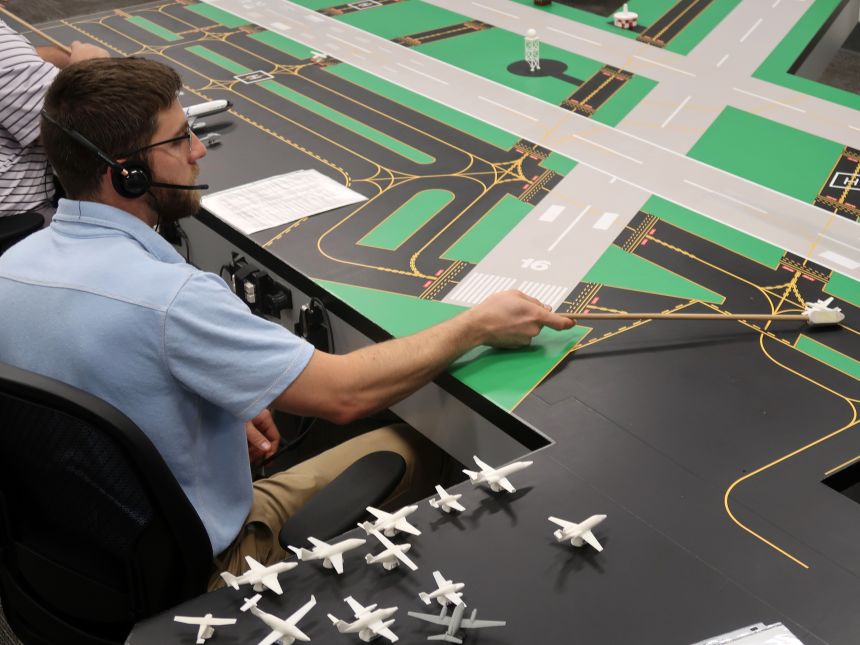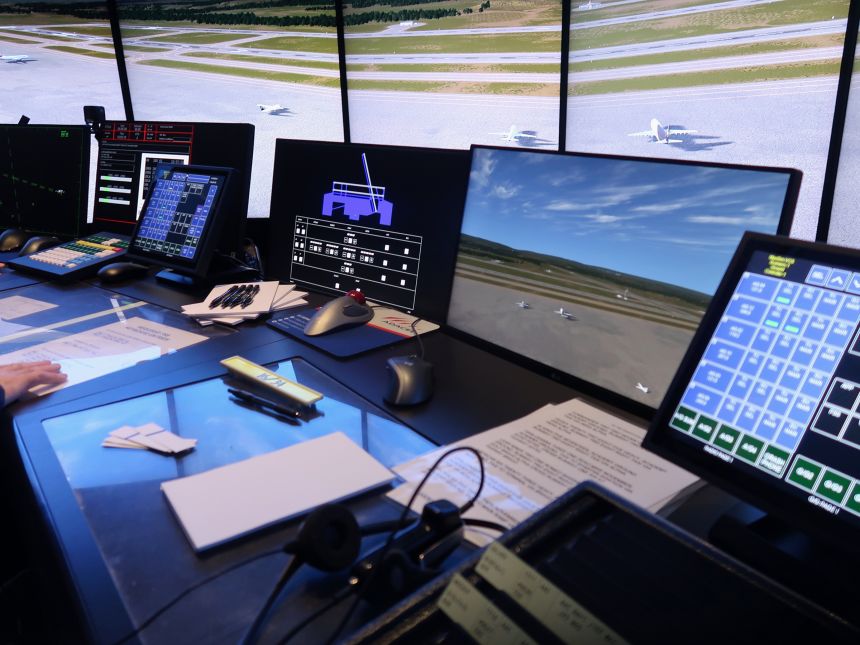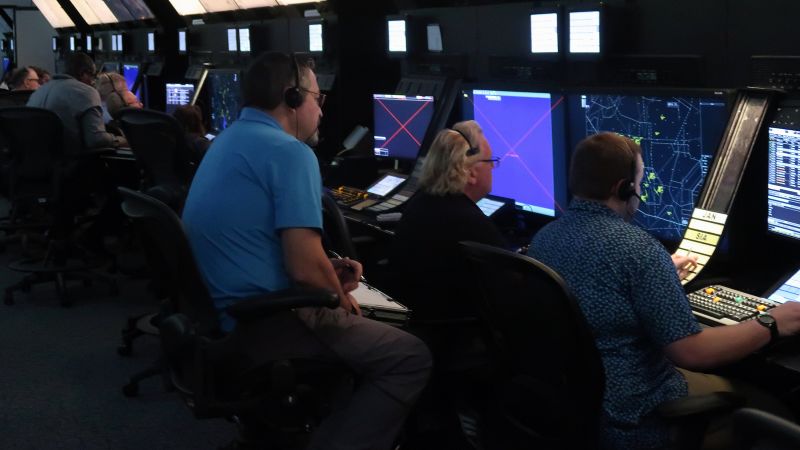Mike Monroney Aeronautical Center – Oklahoma City, OK
—
On a sprawling campus in the middle of the nation, thousands of students learn how to take command of the nation’s skies.
The Federal Aviation Administration Academy, near the Oklahoma City airport, has been a fixture since late 1946, six years before the first commercial passenger jet flight.
In it, rooms filled with monitors show simulated airplanes taxiing on runways and taking off – all under the watchful eyes of students learning to keep the flying public safe. In another room, tiny airplanes sitting on tabletop boards painted with runways are testaments to how quickly one false move can make everything go wrong. Today, they are just models. Soon they will be real planes filled with passengers.
It’s here, at the 1,100-acre campus of the Mike Monroney Aeronautical Center, that the agency trains students to fill the over 3,000 air traffic controller jobs needed to end a decades-long shortage. This year, the FAA has expanded its onsite training by nearly 30%, with July seeing the highest number of students in training – 550 by the end of the month.
The pressure and expectations are high. The center’s graduates together work nearly every flight in the country – over 85,000 a day – carrying 2.5 million passengers to 20,000 different airports, according to Oklahoma City estimates.
The academy “is the introduction into air traffic,” said Chris Wilbanks, FAA vice president for mission support. “This really is giving the students the base of what air traffic really is, introducing them slowly into kind of a walk-run phase, get into the simulation, then off to the field they go.”
Following January’s midair collision between an American Airlines regional jet and an Army Blackhawk helicopter near Washington in which 67 people were killed, the Department of Transportation announced plans to “supercharge” the air traffic control workforce. Salaries for trainees at the academy increased by 30%, and the agency shaved four months off the old hiring timeline.
The Academy is now the “busiest” it has ever been, Wilbanks said, with roughly 800 to 1,000 more trainees in the pipeline than a year ago.
The FAA pays training at the academy and students receive an hourly salary while they are enrolled. If students choose to go through a different program, like an FAA-supported college program, that may require them to pay tuition.
Before a potential controller can even step foot in the academy, there’s a rigorous application and qualification process. Under a five-step plan, they must pass an aptitude test; clear medical and background checks, then receive an offer to start training.
A hiring push earlier this year referred 8,320 candidates for the required exam, though typically 90% of candidates don’t make it in, and 35% of the others wash out.
New controllers must also be younger than 31, and many on this campus are 19 or 20, which gives the facility the feel of a small college.
After admission to the academy, students start their training with tabletop exercises. The small model planes and painted runways look like game boards, but they are designed to teach phraseology – the language of air traffic control – and maps to new trainees.

“Academy Ground, Barron 4LY request taxi to main ramp,” a student says during a recent exercise.
“Taxi to main ramp, via Delta,” the trainee controller responds as the model plane is moved along the board.
“If you don’t know where the aircraft is when he calls you, you’re already behind the game,” Wilbanks said. “Getting that understanding of what the airport layout is when they call you at a visual point, or they call you coming into a certain runway, you’ve got that reference to be able to look out there right then and there.”
Once a student moves out of tabletop training, they go on to tower simulations in wide rooms filled with video screens covering the walls – replicating the view at a real airport.
“We absolutely don’t cut corners,” Wilbanks said. “This is the basics of air traffic.”
Outside the virtual tower windows is “Academy Airport,” a fictious airfield with two parallel runways and a third cutting across them at an angle. There are real-looking airplanes on runways with proper lighting and even cracks visible in the virtual pavement.
With a headset on and the push of a talk button, a trainee can take on the role of an air traffic controller.
“FedEx 2285 heavy, academy Tower, hold short runway 28, right.”
It’s a routine command – asking the simulated pilots to prepare for takeoff but not start rolling until given more instructions.
“(If) we’ve got somebody on the runway in position. We want to make sure we never forget them,” said Eric Wedel, the FAA’s course coordinator for tower training. He has been an instructor at the Academy since 2017 and was a controller for 28 years before that.
Every new controller at the academy is different, he said; some pick it up quickly, while others require a lot of training.
There’s paper and pens – should a controller want to write down a call sign or something to jog their memory in the heat of the moment and runway-use memory aids. Just like you’d find in a real tower.
Instructors also stress that trainees learning to work in towers should look out the virtual windows to observe aircraft rather than just relying on radar. That’s where they find important pieces of information that may have been overlooked or forgotten.

“Radar is an extension of the eyeballs,” Wedel said.
While the simulator can create rain, snow and wind conditions, there are some things that can’t be duplicated outside of a real tower.
“It’s a lot like the real thing, but in some ways it’s not,” Wedel said. “It’s hard to duplicate a certain accent from a pilot or certain situation. There’s unique aspects to air traffic control that it’s hard to capture in a simulation. It’s very close.”
Downstairs in a darkened room, a line of students sit looking at radar scopes and computer monitors. It’s here they train to operate in radar control centers, often far away from the planes they are directing.
“N800BA, declaring an emergency. They lost hydraulic pressure, requesting firetruck to standby,” a trainee calmly says responding to a virtual emergency as his instructor watches over his shoulder.
“Follow through on that one,” another instructor says pointing out an errant plane to another student.
At the same time, the students have to keep track of turbulence and other factors that might disrupt planes trying to navigate the airspace.
While these days a voice recognition computer often listens to the trainees’ commands and reacts to them in real time, the FAA also hires people to operate as pilots on the other end of the radio to better emulate real-life situations.
“It is a tremendous amount of pressure,” Wilbanks said. “Multiply that by 10 and put that in the real world. Giving people the opportunity to experience that feeling here before they step out and experience in real life is absolutely critical, but it is absolutely a rewarding job.”
Graduates of the academy are placed in towers and radar centers across the country, where training continues for one to three years before they become certified professional controllers.
Graduates of the Academy earn an average of $160,000 per year after three years in the field, according to the FAA. Controllers have a mandatory retirement age of 56 but can retire at age 50 with 20 years of service. The DOT has been pushing for controllers in their 50s to stay on to help alleviate the staffing shortage.
It may take years of hard work to recruit and train students to close the staffing gap, but for the would-be controllers at the FAA academy there is nothing like the job.
“There’s an old saying, ‘Air traffic control is 90% slow and boring and 9% exciting and 1% Oh my gosh,’” Wedel said. “Every day is different.”
CNN’s Devon M. Sayers contributed to this report.

